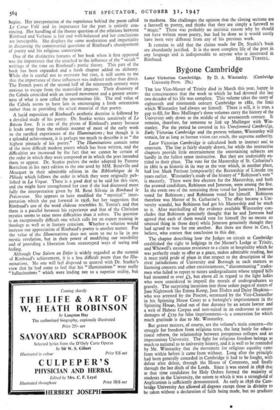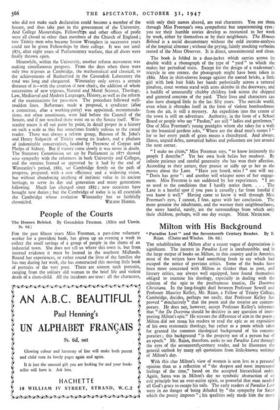Bygone Cambridge
THE late Vice-Master of Trinity died in March this year, happy in the consciousness that the work to which he had devoted the last two decades of his life was complete. This volume takes the story of eighteenth and nineteenth century Cambridge to 1882, the limit which Winstanley had always set himself. There is still, it is true, a gap lo fill, for Bass Mullinger's three volumes carry the history of the University only down to the middle of the seventeenth century. It remains, therefore, for someone to link up Mullinger with Win- stanley. For the period he covered in his Unreformed Cambridge, Early Victorian Cambridge and the present volume; Winstanley will remain, for as long as human vision can reach, the supreme authority. Later Victorian Cambridge is calculated both to instruct anc: to entertain. The line is fairly sharply drawn, for while the instructive chapters provide little entertainment the entertaining subjects are hardly in the fullest sense instructive. But they are undeniably en- titled to their place. The vote for the Mastership of St. Catharine's in 186i is as historic in its way as the vote which, in another place, had lost Mark Pattison (temporarily) the Rectorship of Lincojn ten years earlier. Winstanley's study of the history of "Robinson's vote" is masterly. There were five electors for the Mastership, and both the avowed candidates, Robinson and Jameson, were among the five. In the event two of the remaining three voted for Jameson ; Jameson voted for Robinson ; and Robinson voted for himself. Robinson therefore was Master of St. Catharine's. The affair became a Uni- versity scandal, but Robinson had got his Mastership and he stuck to it. After marshalling all the evidence available Winstanley con- cludes that Robinson genuinely thought that he and Jameson had agreed that each of - them would vote for himself (by no means an unusual thing in those days) while Jameson genuinely thought they had agreed to vote for one another. But there are those in Cats, I believe, who contest that conclusion to this day.
The chapter describing how the Judges on circuit at Cambridge established the right to lodgings in the Master's Lodge at Trinity, and Whewell's strenuous resistance to a claim to hospitality which he was perfectly ready to offer as a grace, makes admirable reading, but it must yield pride of place in that respect to the description of the rival jurisdictions of University and Borough in such matters as licensing concerts and other entertainments, " discommuning " trades- men who failed to report to tutors undergraduates whose unpaid bills had mounted to over £5, but above all in regard to the light ladies who were considered to imperil the morals of undergraduates so gravely. The surprising incursion into these sedate pages of sisters of Jane Nightwork like Emma Kemp, Jane Elsden and Daisy Hopkins— who was arrested by the Proctor, sentenced by the Vice-Chancellor in his Spinning House Court to a fortnight's imprisonment in the Spinning House, haled out of that durance by an astute lawyer and a writ of Habeas Corpus and non-suited in an endeavour to secure damages of £15o for false imprisonment—is a concession for which much gratitude is due to Mr. Winstanley.
But graver matters, of course, are the volume's main concern—the struggle for freedom from religious tests, the long battle for educa- tional reform, the relationship between prosperous colleges and an impecunious University. The fight for religious freedom belongs as much to national as to university history, and it is well to be reminded by Mr. Winstanley that the movement for religious equality came from within before it came from without. Long after the principle had been generally conceded in Cambridge it had to be fought, with defeat after defeat, through the House of Commons and finally through the last ditch of the Lords. Since it was state in 1858 that at that time candidates for Holy Orders formed the majority of students in the University, the extent to which it was a stronghold of Anglicanism is sufficiently demonstrated. As early as 1856 the Cain- bridge University Act allowed all degrees except those in divinity to be taken without a declaration of faith being made, but no graduate
who did not make such declaration could become a member of the Senate, and thus take part in the government of the University. And College Masterships, Fellowships and other offices of profit were all closed to other than members of the Church of England ; two Trinity men who became Senior Wranglers in successive years could not be given Fellowships by their college. It was not until 1871, after eight years of Parliamentary warfare, that all doors were finally thrown open.
Meanwhile, within the University, another reform movement was making simultaneous progress. From the days when there were only two triposes at Cambridge, the mathematical and classical, to the achievements of Rutherford in the Cavendish Laboratory the road was long and chequered. Winstanley only covers a certain distance of it—with the creation of new chairs, the addition of whole successions of new triposes, Natural and Moral Science, Theology, Law, Mediaeval and Modern Languages, History, as well as the reform of the examinations for pass-men. The procedure followed well- trodden lines. Reformers made a proposal, a syndicate (alias a committee, alias a working-party) was appointed, recommenda- tions, not often unanimous, were laid before the Council of the Senate, and if not wrecked there went on to the Senate itself. Win- stanley traces it all out point by point, in detail proper in a history on such a scale as this but sometimes frankly tedious to the casual reader. There was always a reform group, Bateson of St. John's and Henry Sidgwick of Trinity among its leaders, and a phalanx of indomitable conservatives, headed by Perowne of Corpus and Phelps of Sidney. But if victory came slowly it was never in doubt. The Statutory Commission set up by Parliament in 1877 showed wise sympathy with the reformers in both University and Colleges, and the statutes framed or approved by it had by the end of Winstanley's period, 1882, set Cambridge firmly on the path of progress, prepared, with a new efficiency and a widening vision, but without abandoning anything of intrinsic value in its ancient heritage, to serve its day and generation and many generations following. Much has changed since 1882; new occasions have brought new duties ; but the Cambridge of today is in all essentials the Cambridge whose evolution Winstanley has so faithfully



































 Previous page
Previous page